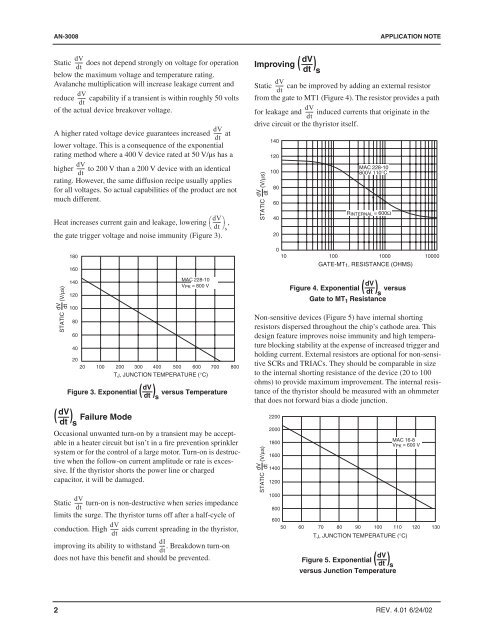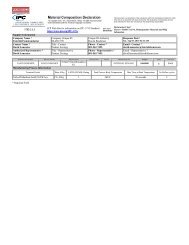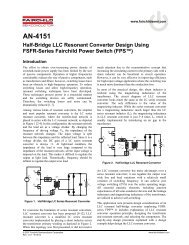AN-3008 RC Snubber Networks for Thyristor Power Control and ...
AN-3008 RC Snubber Networks for Thyristor Power Control and ...
AN-3008 RC Snubber Networks for Thyristor Power Control and ...
Create successful ePaper yourself
Turn your PDF publications into a flip-book with our unique Google optimized e-Paper software.
<strong>AN</strong>-<strong>3008</strong><br />
APPLICATION NOTE<br />
dV<br />
Static ------ does not depend strongly on voltage <strong>for</strong> operation<br />
dt<br />
below the maximum voltage <strong>and</strong> temperature rating.<br />
Avalanche multiplication will increase leakage current <strong>and</strong><br />
dV<br />
reduce ------ capability if a transient is within roughly 50 volts<br />
dt<br />
of the actual device breakover voltage.<br />
dV<br />
A higher rated voltage device guarantees increased ------ at<br />
dt<br />
lower voltage. This is a consequence of the exponential<br />
rating method where a 400 V device rated at 50 V/µs has a<br />
dV<br />
higher ------ to 200 V than a 200 V device with an identical<br />
dt<br />
rating. However, the same diffusion recipe usually applies<br />
<strong>for</strong> all voltages. So actual capabilities of the product are not<br />
much different.<br />
Heat increases current gain <strong>and</strong> leakage, lowering ⎛dV<br />
------ ⎞<br />
⎝<br />
,<br />
dt ⎠s<br />
the gate trigger voltage <strong>and</strong> noise immunity (Figure 3).<br />
dV<br />
STATIC (V/µs)<br />
dt<br />
180<br />
160<br />
140<br />
120<br />
100<br />
80<br />
60<br />
40<br />
Failure Mode<br />
MAC 228-10<br />
V PK = 800 V<br />
20<br />
20 100 200 300 400 500 600 700 800<br />
T J, JUNCTION TEMPERATURE (°C)<br />
dV<br />
Figure 3. Exponential (<br />
dt<br />
) versus Temperature<br />
s<br />
dV<br />
( )<br />
dt s<br />
dV<br />
Occasional unwanted turn-on by a transient may be acceptable<br />
in a heater circuit but isn’t in a fire prevention sprinkler<br />
system or <strong>for</strong> the control of a large motor. Turn-on is destructive<br />
when the follow-on current amplitude or rate is excessive.<br />
If the thyristor shorts the power line or charged<br />
capacitor, it will be damaged.<br />
Static ------ turn-on is non-destructive when series impedance<br />
dt<br />
limits the surge. The thyristor turns off after a half-cycle of<br />
dV<br />
conduction. High ------ aids current spreading in the thyristor,<br />
dt<br />
dI<br />
improving its ability to withst<strong>and</strong> ---- . Breakdown turn-on<br />
dt<br />
does not have this benefit <strong>and</strong> should be prevented.<br />
Improving<br />
dV<br />
( )<br />
dt s<br />
dV<br />
Static ------ can be improved by adding an external resistor<br />
dt<br />
from the gate to MT1 (Figure 4). The resistor provides a path<br />
dV<br />
<strong>for</strong> leakage <strong>and</strong> ------ induced currents that originate in the<br />
dt<br />
drive circuit or the thyristor itself.<br />
dV<br />
STATIC (V/µs)<br />
dt<br />
140<br />
120<br />
100<br />
80<br />
60<br />
40<br />
20<br />
MAC 228-10<br />
800V 110°C<br />
R INTERNAL = 600Ω<br />
0<br />
10 100 1000 10000<br />
GATE-MT 1, RESIST<strong>AN</strong>CE (OHMS)<br />
( ) s<br />
dV<br />
Figure 4. Exponential<br />
dt<br />
versus<br />
Gate to MT 1 Resistance<br />
Non-sensitive devices (Figure 5) have internal shorting<br />
resistors dispersed throughout the chip’s cathode area. This<br />
design feature improves noise immunity <strong>and</strong> high temperature<br />
blocking stability at the expense of increased trigger <strong>and</strong><br />
holding current. External resistors are optional <strong>for</strong> non-sensitive<br />
SCRs <strong>and</strong> TRIACs. They should be comparable in size<br />
to the internal shorting resistance of the device (20 to 100<br />
ohms) to provide maximum improvement. The internal resistance<br />
of the thyristor should be measured with an ohmmeter<br />
that does not <strong>for</strong>ward bias a diode junction.<br />
dV<br />
STATIC (V/µs)<br />
dt<br />
2200<br />
2000<br />
1800<br />
1600<br />
1400<br />
1200<br />
1000<br />
800<br />
600<br />
50 60 70 80 90 100 110 120 130<br />
T J, JUNCTION TEMPERATURE (°C)<br />
( ) s<br />
dV<br />
Figure 5. Exponential<br />
dt<br />
versus Junction Temperature<br />
MAC 16-8<br />
V PK = 600 V<br />
2 REV. 4.01 6/24/02







